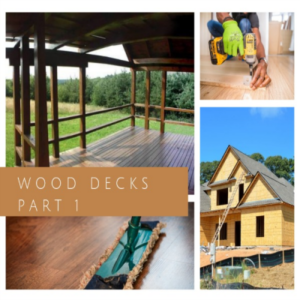Wood Decks Part 1: Design Considerations

Wood decks provide a warm and inviting living space to any home. I have seen all types of wood decks from small and basic to large and elaborate. Regardless of the deck design, it is important to select the proper building material to ensure long-term enjoyment. However, it is important to realize that decks, just like homes, need periodic maintenance.
Naturally Durable Wood
The wood of some tree species is naturally durable. However, a few words of caution are necessary. First, only the heartwood, the dark, inner portion of a log, can be naturally durable and not the outer portion, known as sapwood. Only a handful of tree species have naturally durable wood. For more information on naturally durable wood species please visit our blog post Naturally Durable Wood Species. The decay resistance of naturally durable species will vary within a tree and between trees. So, naturally decay resistant lumber will also vary in its performance. This lumber is typically more expensive than other options. Also, decay resistant is not decay proof.
Preservative-Treated Wood
Prior to January 2004 most wood decks were treated with chromated copper arsenate (CCA). On February 12, 2002, the US EPA announced a voluntary decision by the wood preservation industry to move consumer use of treated lumber products away from a variety of pressure-treated wood formulations that contain arsenic by December 31, 2003, in favor of new alternative wood preservatives. This transition affected virtually all residential uses of wood treated with CCA, including wood used in play structures, decks, picnic tables, landscaping timbers, residential fencing, patios, and walkways/boardwalks. By January 2004 the EPA will not allow CCA products for any of these residential uses. This decision will facilitate the voluntary transition to new alternative wood preservatives that do not contain arsenic in both the manufacturing and retail sectors. The Agency has not concluded that there is unreasonable risk to the public from these products.
Preservative-treated wood continues to provide a cost-effective, safe option for homeowners looking to add a deck or any other outdoor structure. Any treated wood that is cut or drilled has had its envelope of protection compromised. This wood should be field-treated with copper napthenate or bora care. Both of these products are readily available and will provide excellent protection. Note: copper napthenate has a strong, unpleasant odor.
Finishes
The ultraviolet (UV) portion of sunlight will weather the surface of any wood. Oxidation will occur at the wood surface, and the surface will turn gray. Most clear finishes need to be reapplied each year to prevent UV degradation and mold. Pigmented finishes provide better UV protection but hide the natural wood features.
New decks should not be finished until exposed to about two weeks of warm and dry weather. Wood surfaces should be dry to enhance penetration and drying of the finish.
Wood Plastic Composites
An alternative to solid wood for decking is engineered wood plastic composite deck boards. Several companies make these products and they offer the following advantages: no warp or and splintering and will not fade or stain. The wood component of these products is susceptible to insect and fungi attack. However, these products are now preservative-treated to enhance durability. Their major disadvantage is cost. These products are much more expensive than treated wood. Also, there have been complaints that the boards tend to absorb heat and are painful to walk on in summer months with bare feet.
Meet the Author
Dr. Todd Shupe is the President of Wood Science Consulting, LLC. He is a well-recognized expert on wood forensics, wood preservation, wood decay and degradation, and wood species identification. He has a broad background in new product development, quality management, and marketing and sales in both the public and private sectors. For more information please visit DrToddShupe.com.
We welcome your comments below.
Thank you for visiting. We trust that you have enjoyed reading our articles.
Liked this post? Read more below or search for more topics . . .

